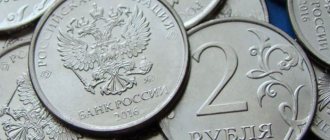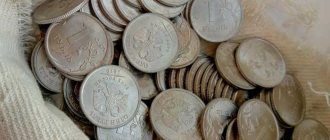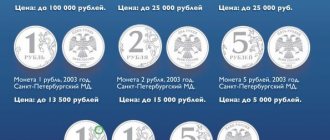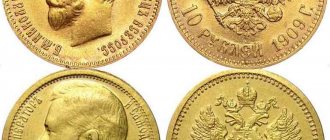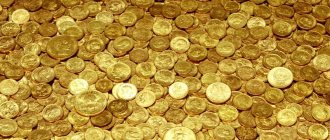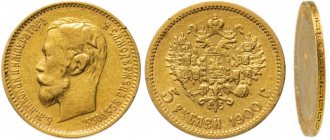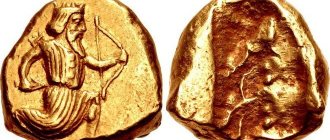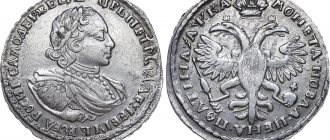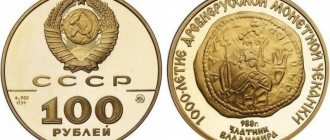The golden royal chervonets (10 rubles) during the reign of Nicholas 2 was minted from 1898 to 1911.
Such a coin circulated on a par with paper bills. Gold coins at that time were issued in huge quantities, so they were available to everyone. Most of these coins have survived to this day, which is why their value and rarity for collectors is low, and the value depends on condition. There are several variations of gold chervonets, differing in designations: The features and differences of each of them will be discussed below, but first we suggest that you familiarize yourself with more detailed current prices of these coins in accordance with their condition.
Golden chervonets 1899 issue
Witte's financial reform at the end of the 19th century had a positive effect on the country's economy. The gold standard was introduced, which meant the recognition of gold as the main monetary commodity, the equivalent of valuables. In 1899, 27 million of these chervonets were issued.
Many countries reduced the weight of silver and gold money, but did not change the denomination. Russia also followed this path. The Nikolaev chervonets began to weigh 8.6 g after the reform. 900 standard metal was used to make money.
Gold coin characteristics:
- The thickness is 1.7 mm.
- The diameter of the gold chervonets is 22.6 mm.
- On the obverse you can see a portrait of the ruler in profile.
- On the reverse the denomination must be indicated, the year of issue was indicated, and the coat of arms was depicted.
- The initials of the mintzmeister were indicated on the edge.
On Nikolaev banknotes of that year there may be the following letters AG (Apollo Grashof), EB (Elikum Babayants) or FZ (Felix Zaleman). It was possible to pay in chervonets in any corner of the Russian Empire. These coins were the equivalent of paper bills. They were minted by the St. Petersburg Mint. Numismatists are still interested in chervonets today; prices for money from pre-revolutionary Russia on the modern market can be different.
Rare varieties
Let us consider by year the varieties that have a high numismatic value.
2009 - price up to 2000 rubles.
Until 2009, 10 rubles were in circulation only in the form of paper money, which quickly became unusable, as well as anniversary and commemorative issues, which were carefully removed from circulation by collectors. Therefore, since 2009, the Bank of the Russian Federation began minting steel 10-ruble coins on a regular basis. Their production cost the state less, and their service life was an order of magnitude longer than their paper counterparts.
The first year, new tens were minted only by the Moscow Mint (MMD). Varieties specialists distinguish 5 types of obverse among the issued coins (see table).
| Varieties of 10 rubles 2009 MMD by obverse | Rarity | Price |
| PC. A. The sign is large, raised to the eagle’s paw | Regular | 15 |
| PC. B The sign is small, raised to the eagle’s paw | Regular | 15 |
| PC. B The sign is shifted close to the paw | Rare | up to 300 |
| PC. G The sign is located in the center between the paw and the letter “I” | Very rare | up to 2000 |
| PC. D The sign is shifted to the letter “I” | Very rare | up to 1500 |
The most valuable varieties are B, D and D on the obverse (designations are given according to the catalog of A. Stashkin). Their price reaches 2000 rubles, but they are rare (less than 2 copies per thousand).
It will take time to learn how to quickly distinguish expensive varieties, but anyone can do it. Look at the photo and pay attention to the auxiliary lines, which can serve as clues in determining the stamps used for minting:
So, by drawing a line that is a continuation of the crossbar of the letter “I”, you can identify varieties that can be sold at a high price.
2010 - cost up to 1000 rubles.
In 2010, both Russian mints (SPMD and MMD) were already engaged in the production of tens. You should look for expensive options among the 10-ruble coins minted in St. Petersburg.
We look at all tens with the SPMD badge; if on the reverse inside the zero the protective lines touch its walls, then the specimen is rare. It costs up to 1000 rubles.
Look at the photo (the usual version has a wide groove between the lines and the inner wall of the zero):
Among the MMD copies of this year there are also variants that are highly valued, but their differences are so small that it is very difficult to identify with the naked eye. See more about them here.
2011 - up to 300,000 rubles.
There are dozens of 2011 models in circulation only with the MMD monogram. It is known that there are several copies of 10 ruble SPMD, but they belong to the category of trial ones. These rare specimens are among the most valuable coins of modern Russia. Their cost is about 2-3 hundred thousand rubles.
2012 - up to 300,000 rubles.
This year, again, mass production of chervonets was only in Moscow. An interesting variant of this coin with thick outer lines in the number zero (a 2009 stamp was used for minting). The cost of this rare variety reached 30,000 rubles. But in recent years, suspicions have arisen in the numismatic community that this variety is a fake, so trading on it is either suspended or the sale price is significantly lower.
And again in 2012, the St. Petersburg Mint minted several copies of tens (either on order, or for trial purposes). Their price is up to 300,000 rubles.
2013 - 100,000 rubles.
There is a unique variety of the 2013 ten, minted at the Moscow Mint. It is interesting due to the differences in the font used in writing the release date. The difference is easily noticeable by the number “3” in the year. On the unique version, the number “3” is not curved, that is, it ends with a straight tail. Such unique varieties are priced from 100 thousand rubles. It is believed that no coins with this date variant were put into circulation. But why not check it out?
2016 - up to 300,000 rubles.
Firstly, in 2021, SPMD, by analogy with 2011 and 2012, is releasing a trial copy of a 10-ruble coin, which, due to its uniqueness, becomes very valuable (costs up to 300 thousand per copy).
Secondly, a new variety (so far only in a single copy) was found relatively recently in tens of 2021 MMDs. You should definitely try to look for this variety. While few copies have been found, their cost will be at the level of 50-100 thousand rubles. The new rare variant is distinguished by its mint mark, which is raised to the paw higher than usual.
2015, 2021, 2021, 2021, 2020
At the time of writing the review, information about valuable varieties among dozens of these years is not known.
As we find new unique specimens, we will update the article.
Anniversary issues
Among the anniversary and commemorative issues there are also expensive copies. We wrote about them in more detail here.
Coins from 1904
The gold ten-ruble note was the most popular among coins of the early 20th century. The differences between the 1904 Nikolaev chervonets and the 1899 gold coin were in the indication of the year of issue. The abbreviation AR was also present on the edge; Alexander Redko was then the mintzmeister.
Many coins were issued in Russia. Such chervonets are found quite often today. The cost of Nikolaev money depends on its safety. The 1904 Chervonets is rarer than coins from earlier years of issue. That's why its price is higher. A sample without defects is worth more than a similar sample with scratches and abrasions.
Valuable mistakes and experiments of mints
Considering the next category of rare 10 ruble coins, it is difficult to say unambiguously about the reasons for their appearance. It is possible that some of them were born as a result of someone’s mistake, but still the bulk of them should be classified as custom-made.
This group of coins includes tens on non-standard blanks: on circles from other denominations, differing in magnetic properties, size and weight. For example, in the photo below there is a ten minted on a mug from 1 ruble. It was sold for 27,000 rubles.
We also include various mules here. For example, on one side there is a ten of regular coinage, on the other there is the obverse of a commemorative banknote. This lot was valued at 28,000 rubles.
The next copy (not as extravagant as the previous ones) with two obverses (the marriage is called “obverse-obverse”) was sold for 7,500 rubles.
With the advent of a large number of such custom-made copies with “mistakes” made to order, the excitement around them subsides and the cost decreases. Therefore, it is doubtful to consider them as a successful investment.
Coins from 1906
The issue of coins was interrupted in 1906. Only 10 gold chervonets were minted. This explains the high price of coins, even if they are far from perfect condition. Collectors purchase such chervonets for a large sum. There are buyers who are willing to pay millions for Nikolaev coins in perfect condition. But there are no offers on the market; ten-ruble notes this year are very rare.
One chervonets is in the Vienna Museum. There is evidence that two more gold monetary units of Nicholas are kept by private collectors in Russia. But where are the other seven coins? This secret has not yet been revealed. Due to the small circulation, the gold coin is considered rare and its price is high. The main difference from the 1904 coin is the year of issue indicated on the reverse.
The minting of money was carried out by the mint in St. Petersburg. There is a version that 10 copies were a trial version. Such a gold coin of Nicholas is in great demand today. They give a good price for this banknote. New chervonets appeared only three years later.
Expensive types of marriage
The quality of the minting of modern 10 ruble coins in Russia is not particularly high; minor defects are often found. Therefore, unstamped or small irregularities (usually along the edge of a zero or one) associated with the destruction of the stamp are of no value.
Dozens without year of manufacture
. The most common marriage. An unmarked issue date, as well as inscriptions, will not interest any collector; the maximum that such a banknote will be good for is to be a bonus to another lot.
Even complete "fat" splits
are valued only up to 150 rubles.
Turns
(misalignment of obverse and reverse) are more expensive, so a turn of 180 degrees can be purchased for 500 rubles.
Bites
are also not particularly valued. A maximum of 200 rubles will be offered for such a defect.
Strong displacement
. For this marriage you can earn up to 4-5 thousand rubles.
You will find a more complete classification of defects with descriptions and prices in the article: “Types of production defects of coins.”
The last coin of Nicholas 2
The 1911 circulation is of interest to numismatists around the world. No one can reliably answer how many chervonets were issued. Officially, 50 thousand copies were produced, but there are many more of them on the modern market. Historians believe that about 11 million coins came into circulation.
There are several versions explaining such a large discrepancy in numbers. The stamps fell into the hands of the Bolsheviks, who continued to secretly mint chervonets. Another version says that it was Admiral Kolchak who issued gold ten-ruble notes for the White Army.
There is an assumption that someone still owns the stamps to this day. This may explain the appearance on the market of new pieces minted recently. Experts have established that weight, purity and other parameters are observed. The coins are made with original stamps. Therefore, there are assumptions that chervonets are still being produced today. No one knows where the stamps are or who owns them.
How to determine the authenticity of a 10 ruble coin from 1901
The option under consideration is one of the most counterfeited, since the value of collectible pieces is high and reaches 170,000 rubles if the condition is decent. But at the same time, fakes differ greatly both in the material of manufacture, and in quality, weight and a number of other characteristics.
The situation is simplified a little by the fact that counterfeit products that are almost indistinguishable from the original are extremely rare. If you remember a few recommendations and check in accordance with them, then even without much experience in this field you can determine the authenticity quite accurately. Most often, a fake has at least one obvious sign, described below.
In 1901, about 2.4 million chervonets were issued. The material used to make the coins was 900-karat gold – high-quality and expensive. And today there are at least several million such options, which shows the real situation and requires special care when purchasing.
Material of manufacture
Judging by the fakes, there are several varieties that are most common. Each of them has its own characteristic features that are worth paying attention to:
How much is a 10 ruble coin from 1901 worth?
It all depends on the condition. Even the original options have a wide price range, so it’s worth considering them individually. Numismatists have a classification according to which the assessment is made:
- PR - the inscriptions are impossible to read, there is serious damage - from holes to missing fragments. G – condition is very poor, but the inscriptions can be made out, there is no serious damage. VG – significant wear, smoothness of all images and letters. All these varieties are usually sold at the cost of gold and have virtually no collection value.
- F – significant wear, but all parts, including small ones, are visible normally. On average, they pay about 42,000 rubles for such copies, but the cost can vary within several thousand.
- VF is in fairly good condition with minor handling marks. There is no contamination, as well as plaque, which often forms over time. Similar options usually sell from 52,000 rubles and more.
- XF – minimal damage, excellent relief, all details are visible perfectly. Similar specimens are priced from 66,000 rubles. and more expensive, it all depends on the situation on the coin market.
- aUNC - not common, usually the surface shows only traces of bag storage, no damage from handling. The price of such products varies widely and starts from 76,000 rubles, often exceeding the starting price by two or more times. It is most valued by numismatists, since finding the perfect 10 rubles of 1901 is becoming more and more difficult every year.
By the way!
Counterfeits cost practically nothing, with the exception of remakes made of gold; they can be sold at the price of the precious metal they contain.
